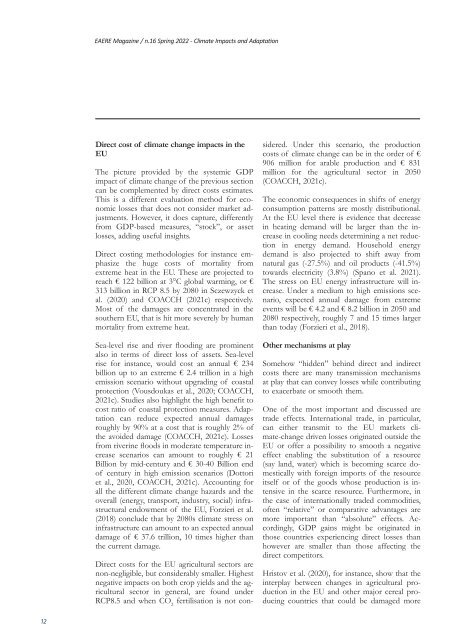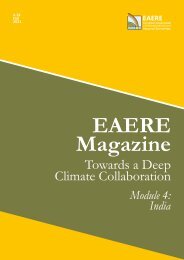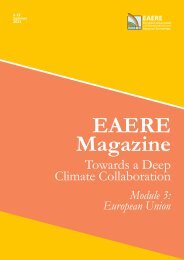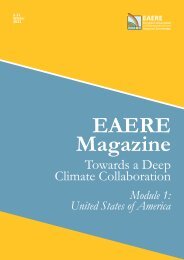EAERE Magazine - N.16 Spring 2022__
Create successful ePaper yourself
Turn your PDF publications into a flip-book with our unique Google optimized e-Paper software.
<strong>EAERE</strong> <strong>Magazine</strong> / n.16 <strong>Spring</strong> <strong>2022</strong> - Climate Impacts and Adaptation<br />
Direct cost of climate change impacts in the<br />
EU<br />
The picture provided by the systemic GDP<br />
impact of climate change of the previous section<br />
can be complemented by direct costs estimates.<br />
This is a different evaluation method for economic<br />
losses that does not consider market adjustments.<br />
However, it does capture, differently<br />
from GDP-based measures, “stock”, or asset<br />
losses, adding useful insights.<br />
Direct costing methodologies for instance emphasize<br />
the huge costs of mortality from<br />
extreme heat in the EU. These are projected to<br />
reach € 122 billion at 3°C global warming, or €<br />
313 billion in RCP 8.5 by 2080 in Sczewzyck et<br />
al. (2020) and COACCH (2021c) respectively.<br />
Most of the damages are concentrated in the<br />
southern EU, that is hit more severely by human<br />
mortality from extreme heat.<br />
Sea-level rise and river flooding are prominent<br />
also in terms of direct loss of assets. Sea-level<br />
rise for instance, would cost an annual € 234<br />
billion up to an extreme € 2.4 trillion in a high<br />
emission scenario without upgrading of coastal<br />
protection (Vousdoukas et al., 2020; COACCH,<br />
2021c). Studies also highlight the high benefit to<br />
cost ratio of coastal protection measures. Adaptation<br />
can reduce expected annual damages<br />
roughly by 90% at a cost that is roughly 2% of<br />
the avoided damage (COACCH, 2021c). Losses<br />
from riverine floods in moderate temperature increase<br />
scenarios can amount to roughly € 21<br />
Billion by mid-century and € 30-40 Billion end<br />
of century in high emission scenarios (Dottori<br />
et al., 2020, COACCH, 2021c). Accounting for<br />
all the different climate change hazards and the<br />
overall (energy, transport, industry, social) infrastructural<br />
endowment of the EU, Forzieri et al.<br />
(2018) conclude that by 2080s climate stress on<br />
infrastructure can amount to an expected annual<br />
damage of € 37.6 trillion, 10 times higher than<br />
the current damage.<br />
Direct costs for the EU agricultural sectors are<br />
non-negligible, but considerably smaller. Highest<br />
negative impacts on both crop yields and the agricultural<br />
sector in general, are found under<br />
RCP8.5 and when CO 2<br />
fertilisation is not considered.<br />
Under this scenario, the production<br />
costs of climate change can be in the order of €<br />
906 million for arable production and € 831<br />
million for the agricultural sector in 2050<br />
(COACCH, 2021c).<br />
The economic consequences in shifts of energy<br />
consumption patterns are mostly distributional.<br />
At the EU level there is evidence that decrease<br />
in heating demand will be larger than the increase<br />
in cooling needs determining a net reduction<br />
in energy demand. Household energy<br />
demand is also projected to shift away from<br />
natural gas (-27.5%) and oil products (-41.5%)<br />
towards electricity (3.8%) (Spano et al. 2021).<br />
The stress on EU energy infrastructure will increase.<br />
Under a medium to high emissions scenario,<br />
expected annual damage from extreme<br />
events will be € 4.2 and € 8.2 billion in 2050 and<br />
2080 respectively, roughly 7 and 15 times larger<br />
than today (Forzieri et al., 2018).<br />
Other mechanisms at play<br />
Somehow “hidden” behind direct and indirect<br />
costs there are many transmission mechanisms<br />
at play that can convey losses while contributing<br />
to exacerbate or smooth them.<br />
One of the most important and discussed are<br />
trade effects. International trade, in particular,<br />
can either transmit to the EU markets climate-change<br />
driven losses originated outside the<br />
EU or offer a possibility to smooth a negative<br />
effect enabling the substitution of a resource<br />
(say land, water) which is becoming scarce domestically<br />
with foreign imports of the resource<br />
itself or of the goods whose production is intensive<br />
in the scarce resource. Furthermore, in<br />
the case of internationally traded commodities,<br />
often “relative” or comparative advantages are<br />
more important than “absolute” effects. Accordingly,<br />
GDP gains might be originated in<br />
those countries experiencing direct losses than<br />
however are smaller than those affecting the<br />
direct competitors.<br />
Hristov et al. (2020), for instance, show that the<br />
interplay between changes in agricultural production<br />
in the EU and other major cereal producing<br />
countries that could be damaged more<br />
12













